
The taxonomy of contemporary classical music—new music, contemporary music, whatever you want to call it—is a thorny issue. But every month, we’ll take a look at some of the best composer-driven music to surface here on Bandcamp, that which makes room for electronic experimentation, improvisation, and powerful takes on old classics.
Maya Verlaak
Trace
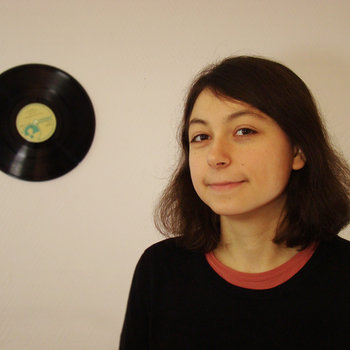

The work of Belgian composer Maya Verlaak retains its homemade quality by using the most quotidian of materials. Her Fluxus-influenced 2012 “Tape Piece,” created with Andy Ingamells, instructs a pair of performers to wrap one another in tape, struggle to reach the end of their rolls, and then try to break free from this handiwork. This new portrait album sticks to more conventional sound sources, with some occasional digital interrogations. Verlaak created each piece with the performer in mind. As she writes in the album notes, “When I write a piece for a friend, or a musician who allows me to get to know the person behind the musician, the inspiration doesn’t grow from the usual superficial observations, but instead from the relationship with the person.” That process yields overwhelmingly intimate pieces where, in some cases, the performer sings wordless melodies alongside the minimal lines they play on their instruments, with computers injecting various unpredictable pitch choices or melodic shapes. On “Whispers,” for example, pianist Kate Ledger plays a series of chords and single notes shadowed by her own halting, almost tentative vocal sounds and deep exhalations, with a live electronic element holding certain passages together.In a piece written for the noted British composer Howard Skempton—“All English Music Is”—accordion sounds are amplified by a small speaker under the score. Its staves are drawn on a piece of fabric, and the signals from the speaker cause a series of small black sponges, which represent specific notes, to bounce around, changing the pitch and forcing the performer to adjust in real time. Ledger was so taken by the piece Verlaak created a version for her, too, starting with a different fragment of a British folk melody than Skempton’s version. The album ends with a tender miniature by Joseph Kudirka, warbling along with a customized music box melody.
Cergio Prudencio
Antología 1: Obras para la Orquesta Experimental de Instrumentos Nativos
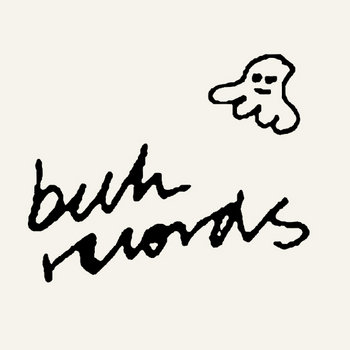


2 x Vinyl LP

Nearly four-and-a-half decades ago, the Bolivian composer Cergio Prudencio launched his Orquesta Experimental de Instrumentos Nativos, a vital rejoinder against colonialism that embraced indigenous sounds and traditions as a legitimate voice against western hegemony in composed music. Although Prudencio has worked extensively in film, scoring many soundtracks, as well as more conventional classical music, this long-running project represents his most visionary, distinctive output. He formed OEIN in 1980, which debuted “La Ciudad,” one of the major works on this career-spanning anthology. From the beginning the ensemble has deployed an arsenal of traditional instruments, clustering different types of charangos (Andean lutes), sikus (Andean panpipes), and various hand percussions to generate otherworldly timbres that freely borrow from European forms. One of the composer’s long-running interests is experimenting with different sorts of unisons—pairing and pulling apart twinned textures and sounds over rhythmic propulsion far-removed from the West. Depending on the composition, we get an almost ritualistic rhythmic intensity (“Catos Insurgentes,” a 2012 piece written for the Jorge Sanjinés film Insurgentes), shimmering contrapuntal strings (“Triptica,” a 1985 feast of charangos), and hocket-like lapidary patterns of terse sikus notes (“Otra Ciudad,” a 2005 complement to that earlier piece named for his native La Paz, where he still lives). I’ve honestly never heard anything quite like Prudencio’s work.
Ekmeles
We Live The Opposite Daring


New York’s Ekmeles are one of the most probing and experimental vocal ensembles in the US, a compact group with an outsized mastery of both ancient and modern approaches. They delve into the past on opening gem “Primo Libro” by British composer James Weeks, the director of Exaudi—which often feels like a sister ensemble to Ekmeles. Weeks created an uninterrupted collection of 16 brief madrigals—in solos, duos, trios, and quartets—written using a 31-tone scale once common in the Baroque era, placing meticulous demands on each singer. The ensemble nails it, taking us back in time while also suggesting something futuristic, with forms and lyrics eluding any clear reference. Zosha di Castri’s title work also collects ancient ideas, recasting texts by Greek poet Sappho and borrowing folk traditions in a three-movement piece that incorporates mouth percussion and other extended techniques from the vocalists. Hannah Kendall’s “this is but an oration of loss” takes material from a poem by M. NourbeSe Philip recounting the brutal story of 130 enslaved Africans that were drowned in 1783, thrown off of a British slave ship; the piece blends rustic harmonica, narrative fragments, onomatopoetic utterances, and swooping harmonies to create a haunting, troubling resonance. Additional pieces by Shawn Jaeger, ensemble member Jeffrey Gavett, and Erin Gee vividly inspire yet further stylistic excursions, all executed with unerring intonation, dramatic flair, and rhythmic vitality, thriving within and outside choral orthodoxy.
Nate Wooley
Moths


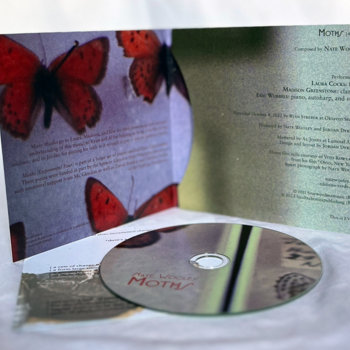


Compact Disc (CD)



When trumpeter Nate Wooley composes pieces that organize improvisation into generous frameworks, he frequently turns to images and models from the natural world for ideas. He originally composed Moths as a solo work, where the performer chooses an initial gesture from the score and that takes light, so to speak, arranging the performance according to four “wing-tips,” each representing a different locus of change or development— harmonic motion, articulation, extension, and physicality. These shifts are achieved very slowly, metamorphosizing in plain sight, but too gradually for most of us to notice until it’s already happened. That pace causes us to put our focus on those changes rather than the grander design. This performance enlists the trio of pianist Eric Wubbels, clarinetist Madison Greenstone, and flutist Laura Cocks. Although each musician works alone, they can’t help but occasionally veer or smudge a sound to enhance some fleeting collective serendipity. At this molasses pace, it’s tough to trace the paths of all three voices at once. As a result, the music becomes kaleidoscopic, as our ears wander from tone to tone, changing perspective and focus. There’s a Zen-like serenity that’s countered by a timbre often spiked with sharp harmonics, sibilance, groans, and microtonal wobbles, and observing it play out feels like the most hypnotic suspense movie one could imagine.
Miharu Ogura
Ogura plays Ogura
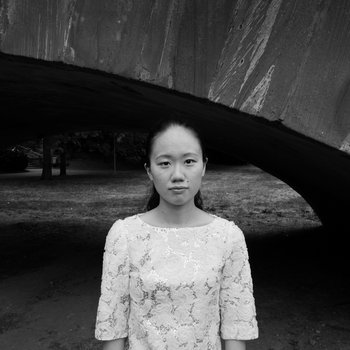





Compact Disc (CD)




Composers are musicians, but for the last couple of centuries, most of them have only appeared on stage to take a bow following a performance of something they wrote. In the early days of classical music, the jobs were often entwined, but the elevation of composing as some kind of separate discipline largely ended that duality. Happily, the tide has been turning in recent decades, with the Frankfurt-based new music specialist Miharu Ogura revealing depths as a composer that match her virtuosity as a piano, an ability brilliantly conveyed last year on a recording of Stockhausen music. Ogura tackles compositions of her own on this strong new recording, something she began doing for the international piano competitions in which she participates. In fact, two of the five pieces featured here won top honors at these gatherings. As the perceptive essay by Jonas Olsson explains, Ogura has gravitated toward works that are physicially demanding, often requiring the keyboardist to cross hands across the instrument—a design that prevents the musician from letting their focus drift. The album opens with the brief “Pas,” an elliptical number that surrounds slowly decaying notes with extended swaths of silence. Ogura wrote that piece as an after-the-fact prelude for “Labyrinthine,” a piece she wrote in 2018 that kickstarted her current output—it won a prize at the Orléans International Piano Competition—a much denser, more visceral work that shares much of the same pitch material. The album reveals the pianist’s deep engagement with the solo piano literature of the 20th century, but her own vision shines through.
Phill Niblock
Looking for Daniel

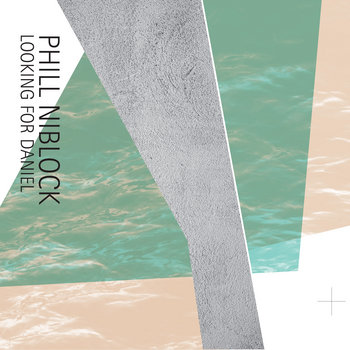

Compact Disc (CD)

Phill Niblock died on January 8 at age 90, packing a life of sound into all of those years. In fact, he was at work until the very end. The opening performance on this typically immersive new album was recorded in October of last year, when the composer was in Berlin for a 24-hour celebration of his music and filmmaking, with a broad array of collaborators performing works from across his lengthy career—including cellist Lucy Railton, synthesizer player Thomas Ankersmit, guitarist Seth Josel, and percussionist Robyn Schulkowsky. “Biliana” is named for Biliana Voutchkova, who recorded closely-tuned if not identical, sustained lines of both violin and voice. The two sources intermingle, generating a beautifully resonant stream of glacial sound. While it’s surface may seem static, dig a little deeper and a new universe opens up as tones ripple in gentle vibrato, with Voutchkova’s wordless voice introducing an almost imperceptible wobble, and as the work unfolds each microscopic twist takes on greater, more profound meaning. “Exploratory, Rhine version, Looking for Daniel” was recorded a year earlier in Amsterdam with Modelo62 and the Scordatura Ensemble, and while the nine combined musicians produce a richer, more multi-textured sound, it achieves similar results, although there is more movement, harmonic interplay, and microtonality at work. Each piece captures a related facet of the composer’s lifelong quest, finding new wrinkles and possibilities in monolithic drones. I’m sure there is more to come from Niblock’s archives, a bounty we should all be grateful for, and a guarantee that his work will keep sounding.
Osnat Netzer
Dot : Line : Sigh


In her liner notes for this multivalent portrait album, the Chicago-based Israeli composer Osnat Netzer explains the musical language that gave the collection its title: “Though the pieces differ in musical language and aesthetics, they all share the tropes of a punctuated sustain (Dot-Line) and many forms of pitch bends, glissandi, and stylized portamenti (Sigh).” Those qualities do, indeed, ripple through these intimate, beautifully proportioned works, injecting into them passages that are alternately halting, arching, and shimmering. But these seven works, mostly recorded ensembles from her adopted base of operations—she teaches at DePaul University—testify to an impressive versatility and range. Ensemble Dal Niente brings stunning sensitivity and grace to the sorrowful “They bury their dead with great ululations,” a work named for the ancient practice of employing women to wail loudly and pull on their hair at funerals to normalize the expression of grief, with the chamber quartet articulating many of those note and phrase manipulation. The music doesn’t scream, but it is deeply felt. Netzer herself plays piano on “Pillars,” a duo with alto saxophonist Geoffrey Landman that seeks to embody the main principles of her compositional thinking. Mivos Quartet are joined by flutist Eric Lamb on the 2014 piece “Schertch (scherzo sketch),” which is fully realized in spite of its title, generating some humor in its collision of classical tropes and dizzying, spiraling lines. My favorite piece is the amusingly titled “I AM SO FUCKING ZEN,” a deliciously microtonal work elucidated with impressive precision by the saxophone quartet ~Nois.
Milan Knížák
It’s Not Quite That Inventive (Sixty Years With Broken Music)





Compact Disc (CD)



Although Czech artist Milan Knížák has enjoyed a long career straddling visual art, fashion, and music, much of his aesthetic concerns date back to his Broken Music, a particular sonic practice he began developing in the mid ‘60s when he was deeply involved with Fluxus. Long before Christian Marclay began creating noisy collages from multiple turntables, Knížák was devising viscerally tactile, destructive modes of sound production using vinyl. He developed a catalog of techniques and concepts—extreme distortion, warping vinyl and, most famously, gluing together shards of different broken records to create something new. He later applied such techniques to his more conventional classical scores—he’s a prolific composer, with over 100 works to his credit. But in 1973, he finally documented the work (hence the subtitle of this new release) although the private tape wasn’t released until 1983 in an ultra-limited artist edition. A subsequent recording of Broken Music has resurfaced on a number of labels, including the most recent iteration from Sub Rosa, but this new double album includes that super rare version. Although John Cage had used turntables in his “Imaginary Landscape,” Knížák was among the first to conceive it as an actual instrument. Every version of Broken Music is naturally unique, and it’s interesting to hear the earliest manifestation. The first disc in the set is a 2020 version of the piece named Broken Rebroken by the Opening Performance Orchestra with the composer, where digital technology jacks up the procedure, adding clarity and updated material to say nothing of much more punishing sonic violence.
Kali Malone
All Life Long


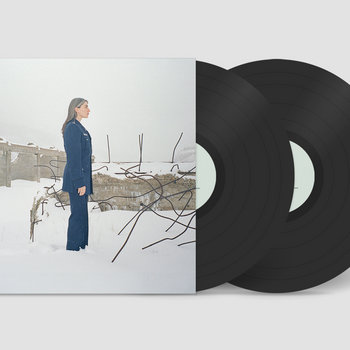

Compact Disc (CD), 2 x Vinyl LP


On this sprawling new album, Kali Malone shares new pieces for organ—the instrument with which she initially built her reputation—for the first time in seven years. Half of the 12 pieces here were performed on a variety of church organs around Europe, with Stephen O’Malley joining the composer on each four-handed work; the other six feature either a choir (Macadam Ensemble from France) or a brass quintet (Baltimore’s Anima Brass). In all honestly, I’ve often preferred Malone’s non-organ music, especially the 2023 just intonation opus Does Spring Hide Its Joy, on which she controls sine tones in a harmonic dance with cello and sustained electric guitar. While I find the organ pieces on All Life Long the most compelling and lucid pieces she’s made for the instrument, several of them are included in arrangements for either brass or voice, and the second versions bristle with a vitality, richer timbre, and sense of interplay that I don’t usually get from the former. The meditative, downward drift of the title piece for organ is unabashedly beautiful, a placid descent that toggles through microscopic harmonic adjustments. The choral version has clear undertones of liturgical music—although the various texts are non-religious—but the contrapuntal elegance and variegated timbre hits me much harder. When Malone allows single chords to linger, harmonic effects kick in and the organ does more with less. Malone hasn’t really altered her approach, but she is getting much better an expressing it.







